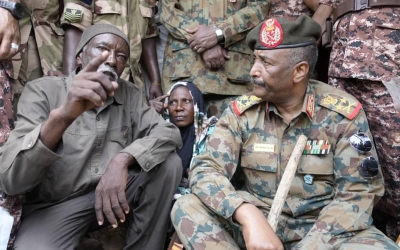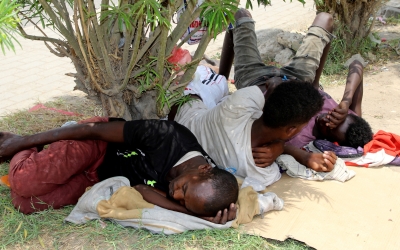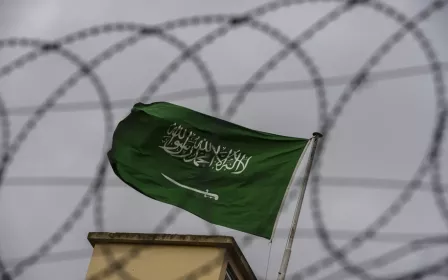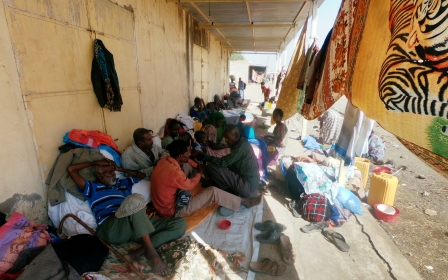Ethiopian survivors recount horror of mass killings at Saudi-Yemen border

Ahmed* still struggles to sleep every night.
Nightmares and memories of his perilous journey to Saudi Arabia through Yemen still keep him tossing and turning when he tries to go to bed.
The 25-year-old Ethiopian embarked on the route in order to flee the conflict at home between the Tigray region's ruling party and the federal government.
Along with thousands of others, he left Ethiopia in November 2022, with one of the closest routes being the Red Sea corridor via Djibouti, leading to Yemen and then Saudi Arabia.
But what he and other asylum seekers didn't expect was to be met with live fire and beatings by Saudi Arabian border guards.
New MEE newsletter: Jerusalem Dispatch
Sign up to get the latest insights and analysis on Israel-Palestine, alongside Turkey Unpacked and other MEE newsletters
“It was quiet, and we walked along a path with dead bodies lying everywhere; some cut to pieces," Ahmed told Middle East Eye.
"Then [Saudi border police] began firing at us. I managed to hide, but a girl who was with me was hit and had her shoulder ripped open. She bled to death right next to us. I think she was 15,” he recounted.
During the attack, Ahmed suffered a serious leg injury, while two people died on the trail.
The route into Saudi Arabia and Yemen has been used by Ethiopian refugees and migrants for years, despite the dangers. Initially, a lack of employment and poor economic conditions caused people to leave Ethiopia in search of better opportunities.
However, a deadly conflict in Ethiopia in which Tigrayans were targeted has now made life impossible for many in their home country.
'I managed to hide, but a girl who was with me was hit and had her shoulder ripped open. She bled to death right next to us. I think she was 15'
- Ahmed, Ethiopian refugee
Ahmed became one of over two million people who were displaced from their homes in Tigray, in northern Ethiopia, and either forced into camps or to find an alternative safe place.
Like many others, Ahmed had to use human traffickers to facilitate his escape.
“I had a kind friend in Saudi Arabia who paid my [traffickers'] fees. I saw them beat up and even kill others who didn’t have the money. I knew it was dangerous, but I thought I would be safe since they got money for me quickly.”
Ahmed says days before his departure, a larger group of around 40 or 50 refugees set off on foot for the Saudi border from a camp in Yemen near the Saudi border. His group was considerably smaller, eight people.
“After a few hours of walking, we began to find bodies everywhere. We began to cry because we recognised many of them. They were part of the larger group and were with us just days earlier.”
Upon reaching a vantage point where they could see many of the bodies, Ahmed says the group paused briefly and tried to count the dead who were visible. That’s when the shooting began.
“They fired at us with a dishka,” Ahmed says, using a term common in Ethiopia for the DShK Russian heavy machine gun. “I can recognise that weapon’s sound from the war in Tigray. It can cut a body in half.”
Ahmed described a tactic whereby border guards would aim and fire at large rocks, which would send shrapnel and stone flying in multiple directions and maximise casualties amongst the refugees.
Saudi border guards also reportedly fired at people using heavy weaponry in order to target bigger groups of refugees, including mortars and other projectile weapons that were sometimes mounted on vehicles.
Ahmed managed to survive the massacre and get medical treatment for his injuries. He now works as a goat herder and lives with the guilt that some of his group were killed and left behind.
“It’s heartbreaking to leave people behind to die. And their bodies are simply abandoned in the desert,” he says.
The Saudi-Yemen route has long been used by refugees seeking a better quality of life.
Yemenis, who are fleeing a country ravaged by conflict since 2014, have also used the route in pursuit of work in Saudi Arabia.
However, in recent years it has become increasingly dangerous, with around 430 deaths and over 650 injuries recorded between 1 January and 30 April 2022.
People have been shot at from close range, while women face sexual harassment, trafficking and rape.
In October, several UN special rapporteurs highlighted the killings in a letter, describing them as "gross human rights violations against migrants".
Rights groups say that the attacks were carried out by Saudi and Houthi forces. But Saudi Arabian authorities have denied responsibility, saying that they did not find any evidence to show flagrant violations of the right to life.
Mass graves
Amongst the migrants who left Ethiopia in early 2022 was Mignot*, who made his way to Yemen.
In the Yemeni city of Saada, around 90 kilometres from the Saudi border, people have been killed by Houthi forces after getting stuck, following failed attempts to reach Saudi Arabia.
It took Mignot around five months to reach the border, where his group faced brutal attacks from border guards.
“We were around 50 people in our group. We left the smuggler prison camp during the call to prayer when the guards look away. Still, I thought we might be safer because there were women and little children walking with us,” the 20-year-old told Middle East Eye.
“First, we heard what sounded like bullets and I saw a few people fall. Everyone began to scream and run, then I heard a loud explosion.
"I remember seeing people screaming in pain, body parts everywhere. I hid among dead bodies and stayed there for hours, soaked in their blood. When it got dark, I got up and ran back in the direction we came from,” he added.
According to Mignot, the dead are left behind and often buried in makeshift mass graves. Meanwhile, families in Ethiopia are left agonising over their disappeared loved ones.
Mignot says that in recent years, it is common to see platforms such as Facebook and Telegram awash with posts in Amharic and Oromo, asking for help finding missing relatives along the Saudi-Yemen border.
A recent report by Human Rights Watch (HRW) corroborates the testimonies of survivors.
According to HRW, Saudi and Houthi border guards shot at refugees at close range, and in some cases asked them which of their limbs they preferred to be targeted.
Nadia Hardman, the report's lead author, said: "Saudi officials are killing hundreds of migrants and asylum seekers in this remote border area, out of view of the rest of the world.
"Saudi border guards knew or should have known they were firing on unarmed civilians," Hardman added.
HRW has called on Saudi Arabia to "immediately and urgently revoke any policy, whether explicit or de facto, to deliberately use lethal force on migrants and asylum seekers, including targeting them with explosive weapons and close-range attacks."
The rights group has also called on Riyadh to investigate and discipline those responsible for the abuses.
*Names of survivors have been changed for their safety and security
This article is available in French on Middle East Eye French edition
Middle East Eye delivers independent and unrivalled coverage and analysis of the Middle East, North Africa and beyond. To learn more about republishing this content and the associated fees, please fill out this form. More about MEE can be found here.







